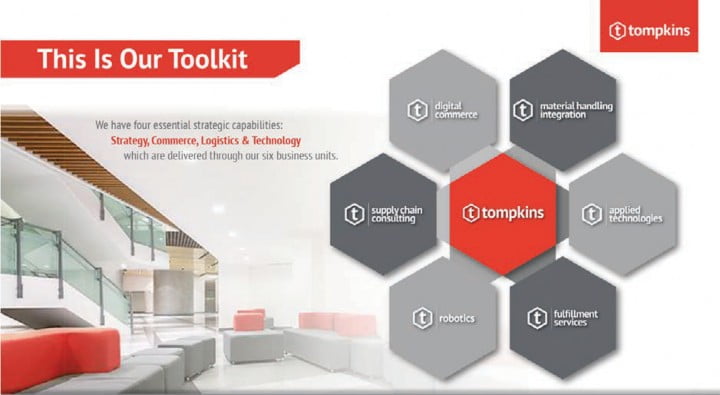Implementing New Strategies for the New Customer Behaviors
#2 OF A 3-PART SERIES ON STRATEGY
GENE TYNDALL
Chief Strategy Officer
Tompkins International
SCOTT MOON
Vice President
Tompkins International
INTRODUCTION
The initial article in this series, “Planning New Strategies for the New Customer Behaviors,” addressed the need placed on executives at all companies to reinvent their businesses to not only avoid revenue losses, but also gain positive performance results. It described the new customer behaviors, their business impacts and the common obstacles and challenges. This included the absolute need to understand the new customer experience (CX) as the critical success factor for digital commerce in 2020 and beyond. Lastly, it introduced the initial tasks in “The Eight Key Steps to Digital Commerce Success,” which involve assessing the readiness for change and developing a roadmap to achieve profitable growth in the increasingly digital commerce world.
This article, then, addresses the implementation of that “planning.” It assumes that your company executives have determined there is the need to reinvent, and that an assessment of its readiness for change has been completed satisfactorily. As with the previous article, this provides executives with information and points of view that act as guidelines for managing the process of reinvention.
At Tompkins International, we maintain a solution set that includes the capabilities of people, processes and technologies organized within our six business units. We know from experience that there are four essential strategic capabilities:
-
Strategy: What should our business and operating strategies look like?
-
Commerce: How do we want to do business commerce?
-
Logistics: What superior logistics do we need?
-
Technology: What technologies will best enable our strategies?

In the next eight sections-representing the eight-step program-we provide information and suggestions for imple- menting the digital commerce reinvention.
The eight steps are not necessarily conducted in sequence. The roadmap determined in Step 1, which is based on the new digital commerce strategy for the particular company, defines the steps, their sequence, their simultaneous tasks and the timing and resources anticipated for each step to achieve the strategy.
Following the eight-step discussion, we include a case example where these steps were used to reinvent a company for digital commerce.
STEP 1: FORMULATE A NEW COMMERCE STRATEGY AND ROADMAP

As introduced in the first article on planning, developing strategies in the new digital commerce world requires a very different mindset-one that understands and values the speed of disruption and change, and the absolute need for flexibility and options. It also requires the total commitment to the CX. We discussed the critical importance of laser-focusing on the new customer behaviors. Developing a strategy for the CX, with direct-to-consumer (D2C) as an implementing channel, however, involves much more than simply establishing a website for the brand. The new strategy must cover each stage of the customer journey-from acquisition to selling to delivery (and returns). Yet, the future is even less predictable than in traditional business planning, and the differences between business strategies (goals) and operating strategies (capabilities) are more pronounced.
Also in the first article on planning, we conveyed the absolute requirement for improving the CX through- out the customer journey on a regular basis, and not just as a one-time strategy. Customers may change
their preferences often, and not just by season. Social media and other sources of information create “opportunities” for customers to explore and possibly change products and sites. This key factor makes the new commerce strategy even more dynamic as a requirement. Knowing your customers and their behaviors is a continuous requirement, which places new types of pressures on strategy development and ongoing execution.
We make use of a special method referred to as the “Accelerated Solution Workshop” (ASW), which engages the executive team in a special two-day event that leverages group genius.
We also use techniques such as strategy maps to best align the vision, strategic alternatives, goals and suggested initiatives. This method facilitates the development of the roadmap, which defines the initiatives and steps to achieve the desired future state for digital commerce.
The results of Step 1, then, produce a digital commerce vision, a strategy to achieve it and its roadmap, which taken together and implemented effectively, achieve the digital commerce reinvention that the company prefers and its customers want.

STEP 2: REINVENT YOUR SUPPLY CHAIN PROCESSES

The next step in the reinvention is concerned with the operational processes of the company. Traditional workflows are most often not effective or efficient for digital commerce. Digitalization of commerce involves faster transactions, leaner workflows and simultaneous operations. Those companies that have used the Supply Chain Operations Reference (SCOR) model to create process designs will need to reassess several for their digitalization readiness. As with strategy maps, workflows need to be redesigned and often repositioned to accommodate speed and flexibility while assuring quality and also raising the bar on services.
Process reinvention requires similar tools that have been used in recent years with traditional processes, such as workflow mapping, lean processing and hybrid testing, for example. The difference is that for digital commerce, the process objectives are not only different but most often new to the company.
STEP 3: REDEFINE YOUR LOGISTICS NETWORK
The network of facilities is a fundamental requirement for digital commerce, as the physical flows of goods need to respond to digital requirements. Network design not only enables the business and operations strategy, but it provides the speed, flexibility and agility of the distribution of goods (and services) in closer proximity to the customer base.
In conducting network designs for companies in the digital era, we make use of several tools, as illustrated below:

STEP 4: SELL ANYWHERE
A significant learning from digital commerce fulfillment is that it is preferable to list the company’s products on more than one marketplace or website, regardless of how popular that site may be-even Amazon, for example. Companies should list their products “anywhere” within reason: marketplaces, select websites, sales channels, retail stores and any others that widen the product buying audience and ordering potential.

STEP 5: MANAGE YOUR CHANNELS
Managing multiple channels has been too challenging until recently, when several new technologies have launched to make this possible. One of these is Etail Solutions, which we have allied and teamed with. Etail is robust and comprehensive and is used by many well-known brands.

STEP 6: OUTSOURCE FULFILLMENT OPERATIONS

Selecting the right fulfillment partner is a critical decision for the company. Just as the process of logistics outsourcing requires evaluating capabilities, culture fit and alignment with the company strategy, so does the selection process for the right fulfillment service provider.
There are subtle differences, however, in logistics outsourcing and fulfillment services. The flexibility and agility required by fulfillment services are more important, as are thought leadership and “trusted advisor” potential. Digital commerce fulfillment is new and more challenging; thus, the service partner should be advising the company as much as it is fulfilling and delivering orders. Pricing for the service is important, but companies should value service at least equally in accordance with the digital commerce strategy and its intended competitive advantages.

The ability of the fulfillment partner to grow with the company-in locations as well as volumes-is a critical success factor.
STEP 7: UTILIZE ROBOTICS AND AUTOMATION

Another critical success factor is the use of the right automation and robotics in order to achieve speed, affordability and quality. The fulfillment partner should have the basic level of robotics as an inherent capability, and
the company might want to augment this depending on volumes, types of products and
speed. The availability of trained labor is an issue and robotics will also impact this concern.
Watch these solutions in action: Tompkins Robotics t-Sort and t-Sort Plus
STEP 8: GROW PROFITABLY
Steps 1-7 implement the digital commerce reinvention for the company. This will have positioned the business with
an operating model that has the capabilities to perform at high levels and grow profitably.
Profitable growth, however, does not occur automatically – it must be managed. This starts with the customer and continues with updates to meet (and, in some cases, exceed) the new customer behaviors and journey. The CX discussed earlier begins with their thinking and travels through to delivery for each order. Customer needs, therefore, fall into any of the following six categories, as suggested by Google:
-
Surprise me
-
Help me
-
Reassure me
-
Educate me
-
Impress me
-
Thrill me
Searches are driven by needs, and orders are influenced by the searches, the customers’ experience with the brand
and the brand’s ability to meet their needs. The CX, in turn, represents the customer supply chain that must be fulfilled. We recognize that companies are struggling with developing or implementing winning strategies for digital commerce. Profitable growth comes from the right strategy, the right implementation and the right management. One of the requirements for the right management is how quick and adaptable the company is in adjusting their digital strategy. Agility is the action term that characterizes a successful profitable growth, which is achieved first by allocating adequate capital and talented resources, and second by redefining how performance is measured. New metrics are needed for profitable growth in the digital world, rather than the traditional measures such as market share or
sales by retailer, for example.
Implementing the 8-step program should be tailored by the company as it redefines its strategy and builds its
roadmap. Next, we summarize a case in which the program was implemented.

A CASE EXAMPLE
This case example summarizes our work with a consumer goods business (company) with a traditional selling strategy for direct-to-retail and wholesale. The company wanted to evaluate an expansion to include a D2C channel, as it was experiencing flat revenues through its traditional retail store sales. As the digital commerce space has grown, they had failed to grow with it.
Digital commerce allows customers the opportunity to shop, buy and receive products when, how and where they want. Understanding customer preferences and click-throughs helps companies accommodate consumer needs and potential likes or dislikes. As the digital marketplace evolves, this consumer products company recognized that the dynamic insights from daily interactions is more valuable than traditional focus group discussions.
The company executives were aware that this strategic shift would put a strain on the business in terms of current retail and wholesale relationships and the order mix which would result. Thus, they decided to engage expert help with a strategic review of their business and development of a plan to establish D2C as a new channel.
APPROACH
We utilized the Tompkins eight-step process that aligns critical resources (people and capital) to develop and deliver optimal business performance. The company needed to move from a bulk, 9-5-based world to a very dynamic 24/7 world, where orders were individual and for smaller quantities.
We initially assessed the current strategy and culture for its readiness to design a D2C channel. Scenarios of operational activities (e.g. supply chain design, fulfillment strategies, delivery requirements) were designed to establish how the business should go to market. With this understanding, the team broke down the high-level strategy into more detailed process maps to better understand critical handoffs, alignments and success factors to efficiently operate in the market.
To jump start the strategic organizational alignment process, we engaged the greater organization using our ASW. This facilitated group workshop involves a strategic discussion with a cross-functional team where all speak candidly and openly about the process and strategy concerns, and the team works through how to solve them. At the conclusion of the two-day meeting, the company was left with a clear alignment of strategies, goals and next steps to lead the implementation of the new digital commerce strategy. In effect, a roadmap was created to guide the work and timebox its development.
The roadmap called for implementation teams on critical areas. For example, one team focused on the essential information and requisite systems to manage the increased complexity. This team defined additional solution requirements, the implementation schedule and the robust data management needed. Each team provided the critical KPIs required to monitor its success, and these were integrated into an executive dashboard for monitoring progress.
RESULTS
Implementation of the solutions required the management of several operational and financial components, which
are summarized as follows:
-
Inventory: The solution involved maintaining inventory levels and not allowing an expansion of assortment to increase inventory. Demand planning tools were introduced to foster internal discussion and alignment on where to tighten inventory ownership and chase demand opportunity. The assortment selections were increased 15% and only a 1% overall inventory increase.
-
Service Level: A main objective of the D2C channel was to provide two-day service anywhere in the nation. It was planned to accomplish this with lower delivery costs, level inventories and fulfillment costs at or below benchmarked targets. By deploying a distributive network where they paid only for the space they used, they were able to provide 99.5% two-day coverage and fulfillment costs 2% below their targets.
-
Revenue Expansion: The company wanted, of course, to expand its revenue base. They expected to increase revenue 20% in year one by implementing the new approach. We deployed the Tompkins digital platform that standardized data and allowed them to market their products in more channels than originally planned. Company revenues increased by 35% in year one, with expected continued expansion through robust social media and other targeted marketing, based on new insights into customer needs and behaviors.
-
Profit: By mapping the business processes and realigning tasks, the company was able to reduce staff by 5% while absorbing the revenue increase. Customer concerns subsided as orders arrived on-time and order fulfillment increased to 99.8%. Overall profit increase was 15%.
The company redesigned their business approach to enable growth and unleash the power of customer conversation. They developed a regular read of customer information to adjust future planning and operational design. They increased growth while reducing operating costs. The ROI and other benefits were achieved and, in fact, exceeded all estimates. This points out the value of reinventing the business for digital commerce in a holistic manner and the value of applying the eight-step solution method for the digital commerce era.
SUMMARY AND CONCLUSION
This article has addressed the preferred methods for implementing a digital commerce reinvention, while the earlier article discussed the changing customer behaviors and thus the imperative to change, adapt and enable. It covers eight steps that need to be addressed in a roadmap defined for the company as it formulates its new strategy. The third article in this series will discuss the case example summarized here in more detail as a case study.
This article merely summarizes the methods to be employed and their rationale. Details on each of the methods, and/or how Tompkins employs them, can be discussed with a Tompkins leader.
Achieving profitable growth in digital commerce is challenging. It is also highly valuable as digitalization continues to expand in all industries, and all companies must commit to meeting the new customer needs and behaviors not only for profitable growth, but in many ways, for survival itself.



